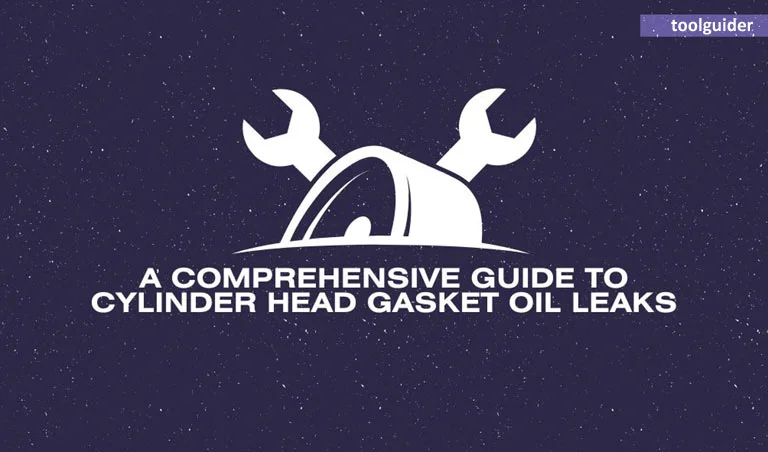Picture your car’s engine as a bustling party, and the head gasket as the vigilant bouncer ensuring that liquids stay in their designated areas. The term “cylinder head gasket oil leak” might sound like auto jargon, but it holds the key to understanding potential issues within your vehicle.
In this comprehensive guide, we’ll unravel the intricacies of cylinder head gasket problems, focusing on the warning signs, identification, and solutions associated with oil leaks. Arm yourself with knowledge to navigate the road of potential car troubles and keep your engine running smoothly.
Warning Signs of a Blown Head Gasket
The head gasket, a seemingly modest component, plays a colossal role in your engine’s well-being. When it falters, it can unleash a series of complications. Here’s a closer look at the warning signs that your head gasket might be on the brink:
- Telltale Leaks: A surefire signal is any departure from the closed fluid system. Whether it’s external oil or coolant, leaks indicate a compromised head gasket, demanding immediate attention.
- Malfunctioning Cylinders: Imagine your car’s cylinders as the heart of the party, responsible for transforming fuel into power. A misfire in these cylinders, especially between two on the same head, could be a clear indication of a head gasket issue.
- Startup Troubles: As your car revs up for action, keep an eye out for white exhaust smoke. This anomaly during startup could be a symptom of a failing head gasket, impacting the critical cooling process.
- Blue Exhaust Fumes: If your exhaust takes on a bluish hue, it’s a sign that your engine is burning oil. This usually happens when oil leaks into the combustion chamber, indicating a head gasket failure.
- Overheating: An overheating engine is never a good sign, and a head gasket failure can exacerbate the issue. When oil infiltrates the coolant system, your engine’s ability to cool down is compromised.
- Fluids: Look for any discoloration in your fluids. While it’s not a common symptom, a head gasket failure can lead to the mixing of oil and coolant, causing a noticeable change in color.
Understanding these warning signs is akin to interpreting your car’s distress signals, prompting you to take swift action to avoid further damage.
How to Identify and Fix Cylinder Head Gasket Oil Leaks
Understanding the nuances between a leaking and a blown head gasket is pivotal. Let’s unravel the signs of a leaking head gasket and explore the steps to identify and rectify the issue:
A. Recognizing a Leaking Head Gasket
A head gasket leak occurs when fluids and gases infiltrate areas they shouldn’t. Your engine’s complex network of channels, transporting coolant, engine oil, and fuel-air mixtures, relies on the head gasket to maintain separation. Over time, exposure to extreme conditions and natural wear and tear can lead to head gasket deterioration.
B. The Difference Between Leaking and Blown Head Gaskets
A leaking head gasket is a precursor to a blown one. While both situations involve gasket failure, a complete blowout usually results from extraordinary conditions like excessive turbocharging or a manufacturing defect. Recognizing these distinctions is vital for timely intervention.
C. Signs of a Leaking Head Gasket
- Increased Engine Oil Consumption: If your vehicle is guzzling more oil between changes, a potential oil gasket leak, possibly from the head gasket, should be investigated.
- Unusual Exhaust Smoke: Standard exhaust is colorless, but a leaking head gasket can introduce coolant or oil into the cylinders, causing distinct color changes. White smoke signals a coolant leak, while a bluish tinge indicates oil combustion.
- Engine Overheating: A leaking head gasket compromises the coolant system’s efficiency, leading to engine overheating. Keep an eye on your coolant levels and watch for bubbles in the overflow tank.
- Visible Oil or Coolant Leaks: Though modern cars often conceal engines under covers, a visual inspection can reveal leaks. Any observed leakage is cause for concern.
- Rough Engine Running: If your engine stumbles or hesitates, accompanied by fouled spark plugs, it’s a classic sign of a leaky head gasket.
- Milky Engine Oil: During an oil change, a milky or coolant-tinted appearance indicates a head gasket leak, hindering oil’s lubricating efficiency.
Head Gasket Failures: Recognizing Symptoms Early
A head gasket’s resilience is tested daily, resisting forces like pressure, temperature, engine vibrations, and shifting. Recognizing early symptoms of failure can prevent catastrophic engine damage. Here are various ways a head gasket can fail:
A. Oil Leak to Outside of Engine
If you notice oil trickling down the engine’s side, it suggests a head gasket breach between an oil gallery and the exterior. Although not an immediate emergency, prompt repairs are advisable to prevent escalation.
B. Coolant Leak to Outside of Engine
Consistently low coolant levels or visible coolant on the ground point to a head gasket breach between a coolant passage and the engine’s exterior. Operating the engine with low coolant can lead to overheating.
C. Compression Leaks to Crankcase
A drop in engine oil levels, coupled with blue smoke from the exhaust, indicates a head gasket failure between a cylinder and an oil gallery. Hot compression gases entering the oil system can compromise lubrication, risking engine damage.
D. Blown Between Coolant and Oil
A milky, frothy sludge resembling a “milkshake” in your engine oil signifies a head gasket failure between an oil gallery and a coolant passage. This scenario demands immediate attention to prevent overheating and severe engine damage.
How to Repair Cylinder Head Gasket Oil Leaks?
The world of head gasket issues offers two paths: repair or replacement. In this section, we’ll explore the available options, comparing the application of head gasket sealants with the more extensive process of head gasket replacement.
A. Head Gasket Sealants: An Affordable Alternative
When faced with a leaking head gasket, the wallet-friendly option is often a head gasket sealant. These products, available at auto supply stores like AutoZone, can be an accessible solution for those looking to curb repair costs. Here’s how to navigate this process:
- Product Application: Head gasket sealants are typically administered via the cooling system. Before application, a thorough flush of the radiator and cooling system is crucial to eliminate debris.
- Sealant Quantity: The right amount of sealant depends on the engine’s cylinder count. Precise measurements ensure optimal performance of the sealant.
- Warm-Up Procedure: Achieving maximum effectiveness requires warming up the engine adequately. This step ensures the sealant settles in and does its job effectively.
- Extended Gasket Life: When applied correctly, head gasket sealants can extend the life of a compromised gasket, providing thousands of additional miles before more extensive repairs become necessary.
B. Head Gasket Replacement: The Comprehensive Solution
While head gasket sealants offer a quick fix, a more permanent solution involves head gasket replacement. Though this approach demands more labor and investment, it might be the only choice for severely damaged gaskets. Here’s what this process entails:
- Labor-Intensive Process: Typically requiring around 10 hours of labor (more if done independently), head gasket replacement involves removing the top section of the engine, cleaning surfaces, and installing a new gasket.
- Financial Considerations: The cost of head gasket replacement can easily surpass $1,500, depending on your vehicle’s make and model. While pricier, it ensures a lasting resolution to head gasket troubles.
- Unrepairable Blowouts: In cases of a blown head gasket, where severe damage is incurred, replacement becomes the sole viable option. Repairing a fully blown gasket is often impractical.
- Consulting Professionals: Due to the complexity of this process, many opt to consult professional mechanics for accurate diagnosis and efficient repairs.
In the realm of head gasket issues, swift action is paramount, whether opting for a budget-friendly sealant or the comprehensive replacement route.
NoLeaky: A Cost-Effective Alternative to Head Gasket Repairs
Picture this: a head gasket replacement costing you anywhere between 2500 to 5000 euros. It’s a hefty expense, one that many have experienced firsthand. But fear not, as I stumbled upon a game-changer—NoLeaky!
Yes, you heard it right! NoLeaky isn’t just a product; it’s a solution to the myriad problems associated with your cylinder head gasket. This magical elixir swiftly tackles leaks stemming from wear and tear, making repairs a breeze.
NoLeaky comes to your rescue in various scenarios. Be it a damaged seal, depressed gaskets, deformed cylinder heads, or even cracked blocks – NoLeaky proves its mettle. Even if your radiator is crying leaks, worry not; NoLeaky transforms it into a watertight fortress.
But here’s the kicker! This product isn’t just making claims; it’s backed by a money-back guarantee. The testimonials from countless motorists attest to its effectiveness. What’s more, NoLeaky isn’t picky—it caters to all types of vehicles.
Whether you’re steering a city car, a sedan, an SUV, or a robust 4×4, NoLeaky has you covered. It’s not limited to just your daily drives; tractors, two-wheelers, quads, boats, and even lawn mowers can benefit from its prowess.
Here’s the cherry on top—it’s incredibly user-friendly. Just turn off your engine, let it cool, pop open the coolant filler cap on your radiator, and pour in the NoLeaky solution. You can also directly pour it into the expansion tank. Start your engine, let it warm up for 30 minutes, cool down completely, add coolant as usual, and voila! Your vehicle is ready to roll.
In essence, NoLeaky emerges as a brilliant alternative to potentially wallet-draining repairs. Priced at a mere 29.90 euros, it’s a small investment with massive returns. Join the ranks of satisfied users who have harnessed the power of NoLeaky to keep their engines running smoothly without breaking the bank.
Final words: Mastering the Art of Head Gasket Care
Hope now you know the expert tips to tackle cylinder head gasket oil leaks. In the intricate dance of engines and gaskets, understanding the nuances of head gasket care becomes paramount. As we explored the intricate web of symptoms, causes, and remedies, it’s evident that proactive measures can save both your engine and your wallet.
From the telltale signs of a head gasket on the brink to the preventive magic of NoLeaky, we’ve embarked on a journey through the engine’s beating heart. Now, armed with knowledge, you’re better equipped to decipher the warnings, act swiftly, and even explore budget-friendly alternatives.
Whether opting for the precision of head gasket sealants or the comprehensive approach of replacement, your decision shapes the fate of your engine. NoLeaky, standing as a beacon of affordability and effectiveness, beckons those seeking a middle ground.
Remember, the road to a healthy engine involves not just repairs but also preventive maintenance. Routine checks, oil analysis, and coolant inspections can unveil potential issues before they escalate, ensuring a smoother ride in the long haul.
As the curtain falls on our exploration of head gasket intricacies, take the reins of your engine’s destiny. Embrace the role of a vigilant caretaker, attuned to the whispers of your vehicle’s needs. Whether you’re steering through cityscapes or conquering off-road terrains, a well-maintained head gasket paves the way for a journey without unwarranted bumps.
Here’s to your engine’s resilience, your wallet’s contentment, and the seamless synergy between man and machine. May your drives be smooth, your diagnostics clear, and your head gasket adventures nothing more than tales of triumph over potential troubles.
Drive on, savvy caretakers of engines. Your journey continues with newfound insights and a roadmap to mastering the art of head gasket care. Safe travels!

I love all things tech, and I wear many hats – tech lover, business starter, digital marketer, and blogger. I know the ins and outs of Digital Marketing, SEO, SEM, SMM, and how to generate leads. My goal? Making things simple for you with clear guides and reviews. I stumbled upon WordPress while creating my first business site, and I fell in love with it right away. When I’m not building websites, creating content, or boosting clients’ online efforts, I’m focused on staying healthy, hanging out with family, and exploring the world. Connect with me on Facebook, Twitter, Linkedin, or read my complete biography.

